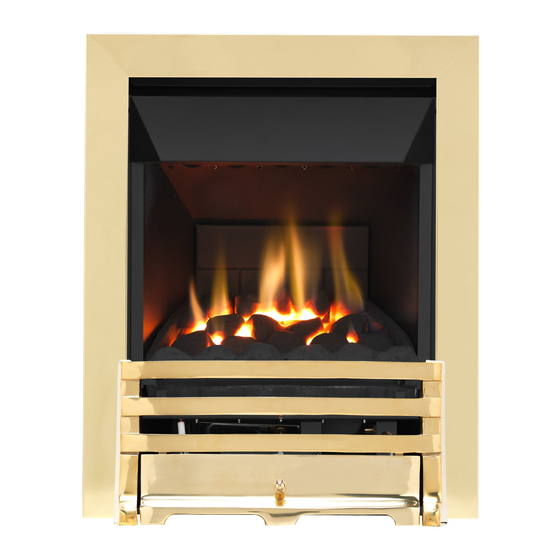Subscribe to Our Youtube Channel
Summary of Contents for Ekofires eko 4010
- Page 1 All instructions must be handed to user for safekeeping Revision A - 08/09 Country(s) of destination - GB/IE eko 4010 eko 4020 high efficiency fuel effect gas fire...
- Page 2 Eko 4010 Eko 4020 Manufactured by : Focal Point Fires plc. Please note : Except where otherwise stated, all rights, including copyright in the Christchurch, Dorset BH23 2BT text, images and layout of this booklet is owned by Focal Point Fires plc. You are Tel: 01202 588 638 Fax: 01202 588 639 www.ekofires.co.uk...
-
Page 3: Table Of Contents
I N S T A L L A T I O N I N S T R U C T I O N S Section Contents Page No. Section Contents Page No. Important Notes Fitting the Burner Appliance Data Final Assembly, Testing and Commissioning Installation Requirements Spark gap Site Requirements... -
Page 4: Appliance Data
2.0 APPLIANCE DATA High Burner Low Burner Inlet Pressure Max Energy Input Min Energy Input Pressure Pressure (±2.0 mbar) (kW) (kW) (±1.5 mbar) (±0.75 mbar) Destination Country Gross Gross Cold Cold G20 G25 G30 G31 18.6 18.1 GB - IE 3.15 Efficiency 90% (net), 81% (gross) -
Page 5: Debris Collection Space
4.0 SITE REQUIREMENTS (continued) This appliance requires a natural draught flue system which may be one of the following; 225mm x 225mm (9in x 9in) brick or stone. 125mm (5in) minimum diameter lined brick or stone. 125mm (5in) minimum diameter twin wall flue conforming to BS 715. Pre-cast block flue complying with BS 1289. -
Page 6: Ventilation
5.0 VENTILATION No purpose provided ventilation is normally required for this appliance. The requirements of other appliances oper- ating in the same room or space must be taken into consideration when assessing ventilation. If spillage is detected when commissioning the appliance, then amongst other problems there may be insufficient nat- ural ventilation for correct operation of the flue. -
Page 7: Preparing The Appliance
8.0 PREPARING THE APPLIANCE Figure 3 The fireplace opening and environment must be in compliance with specifica- tions laid down in the appropriate sections of these instructions. Remove the appliance from it’s carton as described previously and stand upon a dust sheet or similar. -
Page 8: Cable Fixing
8.3 CABLE FIXING Thread both tensioning cables through the holes at the top of the firebox, both eyelets, and back Figure 7 Cable Route through the lower holes in the firebox in the posi- 2. Hold tensioner steady tions indicated in figure 6. Push the appliance back into the fireplace, centralise and pull the loose cables through the holes into the firebox. -
Page 9: Fuel Bed Layout
9.2 FUEL BED LAYOUT Figure 11 1. Remove the ceramic components from their pro- tective packaging, and place the brick panel against the rear of the firebox.Place the ceramic combustion matrix onto the burner. 2. Place the moulded coal piece marked on the underside ‘A’... -
Page 10: Final Assembly
9.3 FINAL ASSEMBLY Refit the glass panel ensuring that the unsupported edge of the glass is facing downwards. Take care not to damage the ceramic fuel bed when fitting. Secure using four M6 screws previously removed. Now fit the hood. This is provided separately. Remove all pro- tective packaging materials. -
Page 11: Setting Pressure
9.5 SETTING PRESSURE The pressure test point is located on the left hand side of the Figure 20 appliance, on the main burner pipe, next to the brass restric- tor/connector. Release the setting pressure test point screw (shown in figure 20), and attach a pressure gauge. Light the fire on the HIGH setting. -
Page 12: Briefing The Customer
10.0 BRIEFING THE CUSTOMER All instructions must be handed to the user for safekeeping. Show the customer how to light and control the fire. After com- missioning the appliance, the customer should be instructed on the safe use of the appliance and the need for regular servic- ing. -
Page 13: Troubleshooting Guide
11.5 REMOVING THE FIREBOX Remove the burner tray as described previously. Protect the hearth from potential damage. Unroll the coiled tensioner cables from the rear of the firebox. Remove the securing nipples and tensioner adjusters. The firebox is now released from the opening and can be slid outward onto the hearth. - Page 14 U S E R S I N S T R U C T I O N S Section Contents Page No. Important Notes Firefront Clearances to Combustibles Servicing Ventilation Operating the appliance Flue Spillage Monitoring System Cleaning Cleaning the ceramic parts 10.0 Shortlist of spares 11.0...
- Page 15 4.0 SERVICING The fire and flue should be checked on an annual basis to ensure all of the product of combustion are entering the flue and that there is no excessive build up of soot. The frequency of service will depend on usage, but MUST be carried out at least once annually.
- Page 16 10.0 SHORTLIST OF SPARES PART NO. ITEM F550324 Pack of coal pieces ‘A, B, C, D’ F780106 Front ceramic strip - coal F780105 Ceramic combustion matrix - coal F550208 Ceramic rear pad F960021 Glass panel assembly F730066 Gas Valve F730080 ODS Oxpilot 9082 TRAY100 Burner assembly...

















Need help?
Do you have a question about the eko 4010 and is the answer not in the manual?
Questions and answers